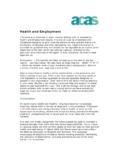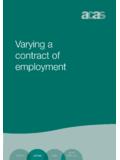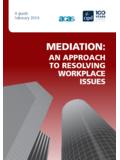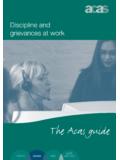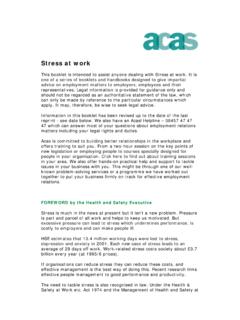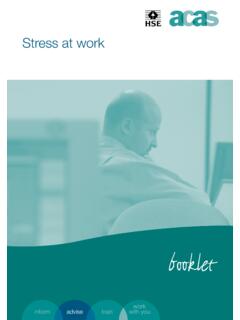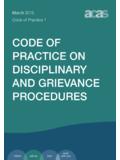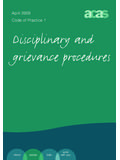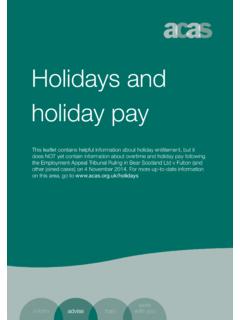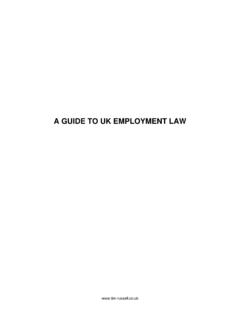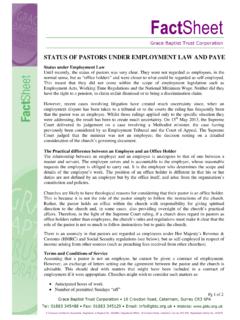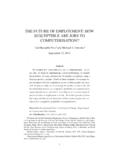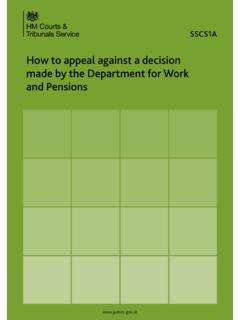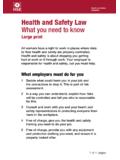Transcription of Settlement Agreements: A Guide - acas.org.uk
1 Settlement Agreements: A Guide 12345678 Acas can helpwith your Every year Acas helps employers and employees from thousands of workplaces. That means we keep right up to date with today s employment relations issues such as discipline and grievance handling, preventing discrimination and communicating effectively in workplaces. Make the most of our practical experience for your organisation find out what we can do for informWe answer your questions, give you the facts you need and talk through your options. Yo u can then make informed decisions. Contact us to keep on top of what employment rights legislation means in practice before it gets on top of you. Call our helpline 08457 47 47 47 or visit our website We advise and guideWe give you practical know-how on setting up and keeping good relations in your organisation. Look at our publications on the website or ask our helpline to put you in touch with your local Acas adviser.
2 Our Equality Direct helpline 08456 00 34 44 advises on equality issues, such as discrimination. We trainFrom a two-hour session on the key points of new legislation or employing people to courses specially designed for people in your organisation, we offer training to suit you. Look on the website for what is coming up in your area and to book a place or talk to your local Acas office about our tailored work with youWe offer hands-on practical help and support to tackle issues in your business with you. This might be through one of our well-known problem-solving services. Or a programme we have worked out together to put your business firmly on track for effective employment relations. Yo u will meet your Acas adviser and discuss exactly what is needed before giving any go-ahead. employment relations needsContentS112345678 ContentsAbout this Guide 3 What are Settlement agreements? 5 Who can enter into Settlement agreements?
3 5 When might Settlement agreements be used? 7 How do you make a Settlement offer? 12template letters 12 What should be covered in a Settlement offer? 13 How do you discuss and negotiate Settlement offers? 15the time you need 15the process that works best 16the people involved 16the sensitivity of the issues being discussed 17 Payment arrangements 18 How to end the employment relationship 18 The formal written agreement 20the legal requirements involved in drawing up a Settlement agreement 20 Confidentiality clauses in Settlement agreements 22 The admissibility of Settlement agreement negotiations in employment tribunals and courts 23 What does without prejudice mean? 23 Settlement AGREEMENTS: A GUIDE2 What are the admissibility provisions of section 111A of the employment Rights Act 1996? 25 How does section 111A apply alongside the without prejudice principle in unfair dismissal cases? 36 How does section 111A apply in cases involving multiple types of claim?
4 37 Discrimination and victimisation and the use of Settlement agreements 38 Settlement agreements and collective redundancies 42 What if a Settlement agreement is not reached? 43 What happens if a Settlement agreement is not honoured? 45 Annex 1: Checklist for employers proposing a Settlement agreement 46 Annex 2: Checklist for employees who have been offered a Settlement agreement 48 Annex 3: Template letter 50 Annex 4: Template letter 53 Annex 5: Model Settlement agreement 56 Guidance on using the model agreement 57 Model Settlement Agreement 65 Annex 6: An illustration of the admissibility of Settlement agreement negotiations in unfair dismissal cases 829101112131415161718 About tHiS Guide 31 About this Guide employment relations concerns can arise in most workplaces employers may be unhappy with an employee s performance or their behaviour whilst employees may feel discontented about the way they are being treated or the work they are being asked to in the workplace are usually best resolved in open conversations, including, as appropriate, through the use of performance management, informal and formal disciplinary or grievance procedures, workplace mediation or Acas , Settlement agreements are also a tool that can be used to deal with workplace problems.
5 Most commonly they are used to help end an employment relationship in a mutually acceptable Guide , which has been considered and approved by the Acas Council, is designed to help employers and employees understand what Settlement agreements are, what their effect is, when they might best be used and how they can be Settlement agreements can be proposed by employers or employees they are usually proposed by employers and this guidance is focused accordingly. nevertheless, the guidance will also be helpful to employees who have been offered a Settlement agreement or where employees are themselves considering proposing Settlement . employees considering these options may wish to seek further advice. this is available from a number of sources including the Acas Helpline, their trade union, their local Citizen s Advice bureau, or an employment Guide focuses, in part, on explaining the law relating to the use of Settlement agreement offers and discussions as evidence in unfair dismissal claims before employment tribunals, as regulated by section 111A of the employment Rights Act 1996.
6 It also provides guidance on Settlement agreements more Guide sets out good practice and has no formal status in employment tribunal proceedings. it should therefore be used in conjunction with the Acas statutory Code of Practice Settlement Agreements (under section 111A of Settlement AGREEMENTS: A GUIDE4the employment Rights Act 1996). the Code is taken into account by employment tribunals when considering relevant this Guide the word should is used to indicate what Acas considers to be good employment practice, rather than legal requirements. the word must is used to indicate where something is a legal ARe Settlement AGReeMentS? 523 What are Settlement agreements? Settlement agreements, formerly known as compromise agreements, are documents which set out the terms and conditions agreed by those involved (the two parties) when they agree to settle a potential employment tribunal claim or claims, or other court can enter into Settlement agreements?
7 Normally it is an employer and employee (or former employee) who are the contracting parties to a Settlement can also be agreed between an employer and someone other than an employee (or former employee) who may be able to bring a claim to an employment tribunal for instance, a worker who has a complaint about holiday pay, or an unsuccessful job applicant who feels they were discriminated against at a job individual Settlement agreement will be signed by two parties and cannot be signed by groups of AGREEMENTS: A GUIDE6 Box 1: Key features of Settlement agreements They are legally binding They can waive an individual s rights to bring a claim covered by the agreement for example, the right to make a claim to an employment tribunal or court The employee (or former employee) usually receives some form of financial payment and will also often receive a reference as part of the agreed terms They are entirely voluntary they include terms and conditions that are mutually agreed, and parties do not have to enter into them if they do not wish to do so They are often reached through a process of discussion and negotiation.
8 The parties do not have to accept the terms initially offered there may be a process of negotiation during which both sides make offers and counter offers Negotiations about Settlement agreements are often confidential in the sense that, if an agreement is not reached, the negotiations may not be admissible as evidence in claims before an employment tribunal or in other court MiGHt Settlement AGReeMentS be uSed? 74 When might Settlement agreements be used? Settlement agreements are normally used to bring an employment relationship to an end in a mutually agreed way. they are often used in situations where an employer and employee feel that their employment relationship is no longer working and a clean break is the best way forward. in these situations both parties can agree the basis for bringing the employment to an can also be used to reach an agreed and final conclusion to a workplace dispute or issue which does not result in an end to the employment relationship.
9 For instance, a Settlement agreement may be used to resolve a dispute over holiday pay. examples 1 and 2 illustrate how they might be used by an employer and an AGREEMENTS: THE ACAS GUIDE8 Example 1: How a Settlement agreement might be used by an employerJohn has been working for his employer as a sales representative for ten years. The company has recently had to reduce the number of sales representatives it employs and, as a result of discussions, John has agreed to move from his sales role to an administrative role in head ongoing attempts by his employer to support and encourage him to adapt to his new job, John is struggling to perform his new duties to a satisfactory level. John is unhappy in his new role and his difficulties are beginning to impact on the performance of others in head office. In discussions with his manager, John has let it be known that, whilst he appreciates the efforts his employer is making to help him, he feels he will never be able to adapt to his new job and he is becoming increasingly demotivated.
10 In view of this, and his previous good work as a sales representative, the company decides to offer John a Settlement giving the matter due consideration, discussing terms and taking independent advice, John decides to accept the offer. He leaves the company with an agreed one-off payment and a good reference, which he feels will put him in a good position to look for a new job as a sales representative, and the company has the reassurance that John will not raise an employment tribunal claim against MiGHt Settlement AGReeMentS be uSed? 94 Example 2: How a Settlement agreement might be used by an employeeMagdalena and Zoe are members of the IT team in a financial services company. Each is highly motivated in their work and has expertise that is valued by the company. However, they have never got along well with one another on a personal level. When their colleagues begin to mention that this personality clash is having an adverse effect on the performance of other members of the team, their manager, Raman, tries various ways to improve relations between them, but without any lasting all parties now feeling that the situation may never improve significantly, and with everyone somewhat at a loss as to how to proceed, Magdalena begins to consider whether a Settlement agreement may provide a way forward.
